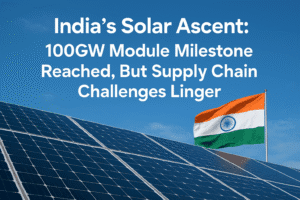India’s Solar Ascent: 100GW Module Milestone Reached, But Supply Chain Challenges Linger
India has achieved a landmark 100GW in domestic solar module manufacturing capacity, a dramatic surge from just 2.3GW in 2014. This explosive growth, fueled by deliberate government policies like the ALMM list (mandating domestic content for projects) and the PLI incentive scheme, marks significant progress towards energy security and the “Atmanirbhar Bharat” vision. However, this milestone exposes a critical vulnerability: heavy reliance on imported solar cells and wafers, primarily from China, persists due to the complexity and cost of upstream manufacturing.
While recent efforts to expand the ALMM to include cell producers and rapidly grow cell capacity (nearly tripling in a year) are positive steps, building a fully self-sufficient solar supply chain remains an urgent challenge. India’s manufacturing success is also attracting global attention, evidenced by a new US anti-dumping investigation into its solar exports. Reaching 100GW modules is a major feat, but conquering the upstream value chain is the true test for lasting solar sovereignty.

India’s Solar Ascent: 100GW Module Milestone Reached, But Supply Chain Challenges Linger
India’s clean energy ambitions have powered past a significant landmark: domestic solar module manufacturing capacity has now exceeded 100 gigawatts (GW), a monumental leap from a mere 2.3GW just over a decade ago in 2014. Energy Minister Pralhad Joshi’s announcement marks a pivotal moment in the nation’s journey towards energy self-reliance, yet also underscores the complex challenges remaining in building a fully sovereign solar supply chain.
From Humble Beginnings to Manufacturing Powerhouse
This explosive growth, particularly accelerating with over 25GW added in 2024 alone, isn’t accidental. It’s the result of deliberate and forceful government policy:
- The ALMM Anchor: The cornerstone is the Approved List of Models and Manufacturers (ALMM). Introduced for modules in 2021 (expanding from 2019), this list dictates which manufacturers are eligible for government-supported solar projects. Crucially, it has overwhelmingly favored domestic producers. The number of ALMM-registered manufacturers has surged from 21 to 100, operating 123 facilities nationwide.
- PLI Fueling Investment: The Production Linked Incentive (PLI) scheme has acted as a powerful financial catalyst. By directly incentivizing large-scale domestic manufacturing, it de-risked investments and spurred the rapid capacity expansion Joshi highlighted.
- “Atmanirbhar Bharat” in Action: This achievement is framed as a major stride towards Prime Minister Modi’s vision of a “Self-reliant India” (Atmanirbhar Bharat) and the critical national target of 500GW non-fossil energy capacity by 2030. Robust domestic manufacturing is seen as essential for energy security and meeting these colossal deployment goals.
The Persistent Gap: Beyond Modules
While the 100GW module milestone is cause for celebration, it reveals a stark vulnerability further up the value chain:
- Cell & Wafer Dependency: Manufacturing solar cells and even more so, polysilicon wafers, is significantly more capital-intensive, technologically complex, and time-consuming to establish than module assembly. India’s capacity here lags far behind.
- The China Reliance: This gap forces continued heavy reliance on imports, particularly from China. Recent data (Ember report, Jan-June 2025) confirms monthly imports of Chinese cells and wafers have actually increased, highlighting the persistent dependency despite module growth.
- Addressing the Weak Link: Recognizing this critical weakness, the government recently expanded the ALMM to include solar cell manufacturers. Six companies with a combined 13GW of annual cell capacity were added. This follows a near-tripling of cell capacity in the year leading up to March 2025. Sustaining this upstream growth through ALMM support is now paramount for true supply chain sovereignty.
Global Ripples and Rising Scrutiny
India’s burgeoning solar manufacturing prowess hasn’t gone unnoticed internationally:
- US Trade Probe: In a significant development, the US Department of Commerce launched antidumping and countervailing duty (AD/CVD) investigations earlier this month into solar imports from India (alongside Indonesia and Laos). This reflects concerns about potential unfair trade practices and signals that India’s export ambitions will face intense scrutiny in key markets like the US.
The Road Ahead: Milestone Reached, Journey Continues
Reaching 100GW of domestic module capacity is an undeniable testament to India’s policy focus and manufacturing potential in the clean energy sector. It provides a crucial foundation for deploying vast amounts of solar power domestically and enhances energy security.
However, the celebration must be tempered with realism:
- Bridging the Upstream Gap: Successfully replicating the module boom in cell and wafer manufacturing is the next critical frontier. Without this, the “self-reliant” ecosystem remains incomplete and vulnerable to external supply shocks and pricing.
- Navigating Global Trade: The US investigation is a stark reminder that scaling exports will involve complex trade dynamics. India must strategically navigate these waters while continuing to bolster its domestic market.
- Quality & Competitiveness: Maintaining high quality standards and cost competitiveness against established global players, especially as subsidies evolve, will be essential for long-term viability.
Conclusion
India’s 100GW solar module milestone is a remarkable achievement born from focused policy. It marks a giant leap from near-total import dependency a decade ago. Yet, the journey towards a truly resilient, vertically integrated solar manufacturing powerhouse is far from over. The challenge now lies in conquering the upstream bottlenecks and strategically navigating an increasingly competitive and scrutinized global market. How India addresses its cell and wafer dependency will be the true measure of its long-term solar manufacturing sovereignty.
You must be logged in to post a comment.